
Colonies on Mars and sustainable construction with human blood proteins?
An interview with Aled Roberts.
"Phosphorus recovery," explained Henry telegraphically. "On their way up the chimney the gases go through four separate treatments. P2O5 used to go right out of circulation every time they cremated someone. Now they recover over ninety-eight per cent of it"... Henry spoke with a happy pride, rejoicing whole-heartedly in the achievement, as though it had been his own. "Fine to think we can go on being socially useful even after we're dead. Making plants grow."
Aldous Huxley / Brave New World, 1932
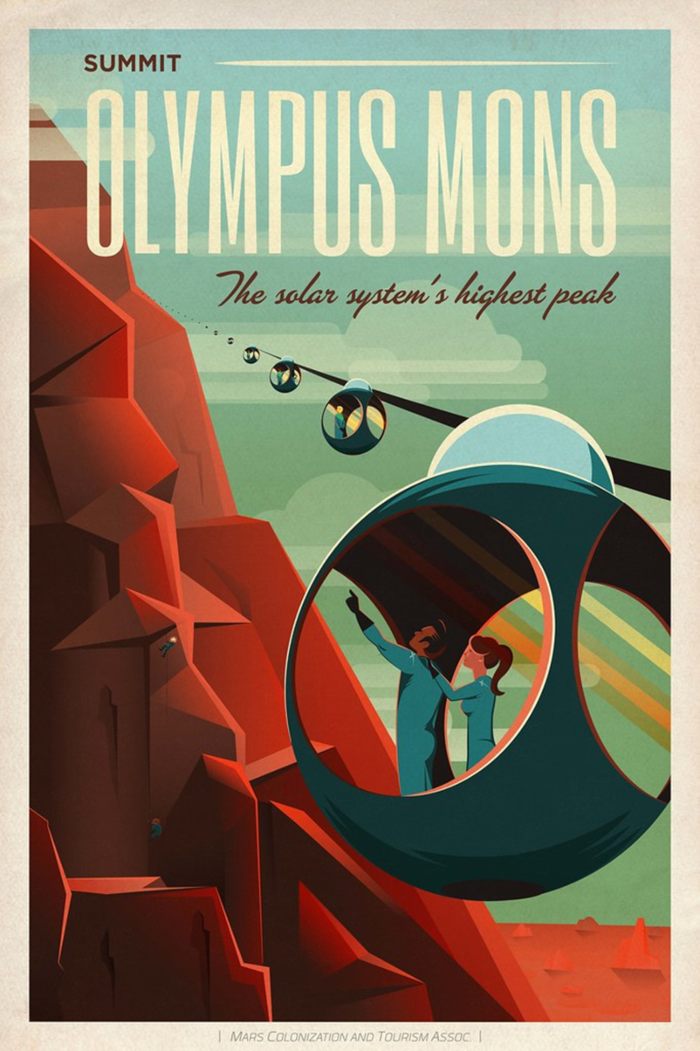
The idea to use the constituents of the human body as valuable resources has been present in different forms throughout history.
The passage from Aldous Huxley’s Brave New World came to my mind when reading about Dr Aled Roberts’ research to create building materials by mixing Mars dust with constituents from human blood.
Sometimes, scientists come up with ideas that capture the public imagination. This one, from a Manchester-based scientist, has gained the attention of both the media and the public (50 news articles and counting!).
However, I thought the news articles and press releases had not delved into the social and ethical considerations and the public's reactions remained somewhat unanswered. Therefore, I sat down with Dr Roberts to give him a chance to reflect on the implications of his work.
I found tweets using PlumX metrics and presented them to Aled to open up discussion regarding his project.
What was the purpose of this work and why is it important?
"While doing this study, we accidentally found through a control experiment that a protein called bovine serum albumin, which is a protein from cow's blood, was really good at sticking glass together. First, afraid of mistakes, we thought our control experiment had gone wrong. You know, that's the purpose of the control experiment, to double-check that you're doing things properly, and we weren't expecting to see it being sticky, but it was very sticky.
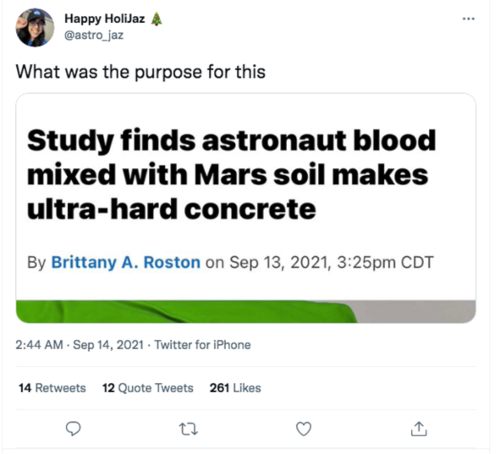
"So then we were scratching our heads up there thinking what have we done wrong? Why is this? Why has this gone wrong? But then we realised that actually, it was because the protein was very sticky. It was a very good find!”
This reminded me of the quote, “the most exciting phrase to hear in science is not Eureka! But (rather) that's funny” - Issac Asimov.
He told me that the Romans had provided a historical precedent for using blood in building material and that the main ingredient must have been albumin. So Aled’s team were re-discovering, rather than discovering this technology.
Aled said: “Well, if we can stick two pieces of glass together, it should also be able to stick sand together. It worked and it held together quite nicely. So then we thought that Moondust and Mars dust are quite similar to sand and this would be more exciting, more interesting than ordinary sand.”
He told me that all mammals, including Humans, produce this protein (Serum Albumin) in their blood.
Aled continued: "You can't really get cows to space but Humans are going to be there, you know, by definition, so why don't we see if that would work? And then we thought, great… let's make a study out of this.
“So if you can use any resources that (the astronauts) produce themselves, it saves having to take it from Earth. It would be an example of in-situ resource utilisation.”
He explained the advantages of using human-derived products rather than lifting large steel bio-reactors which would be costly in terms of rocket fuel and space on the ship.
Why do you think this study has got such interesting and mixed reactions?
“Mars is red for the same reason blood is red, the iron.
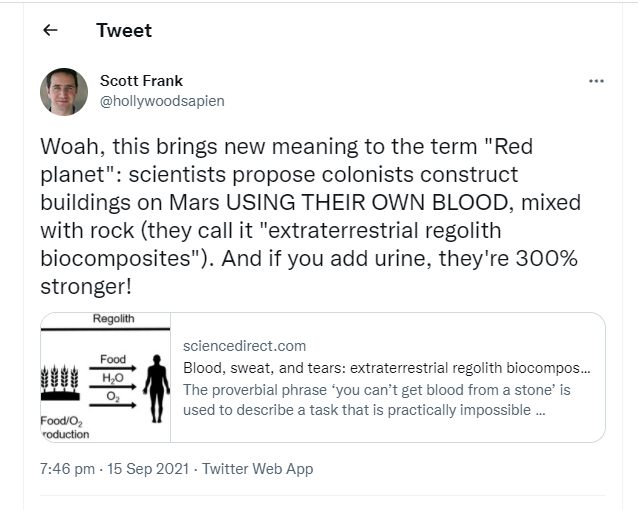
"When early astronomers were studying the heavens, and looking at Mars, they noticed it was blood-red in appearance, associating it with the god of war. So there's kind of a nice kind of circularity (with the tweet).
“I think this work strikes that right balance of being slightly disturbing, but it also does have the backbone of science.
"You know, it was a peer-reviewed, published work. So the fact that legitimate scientists are actually proposing this, although it was kind of tongue in cheek.
"I think it just kind of struck a chord with the public because yeah, it’s a bit weird, crazy and eccentric.”
Do you think your role as a material scientist changes your view of the constituents of the human body, as a resource compared to a member of the public?
“Yeah, it's true that when I do see the human body, I do think about it in terms of its material components, especially when thinking about space, exploration of space travel, because, if we do, go to Mars, or establish long term colonies on the moon, we are going to have to be hyper resourceful.
"This notion of hyper resourcefulness, you have to do it for space. It's just a matter of survival and not wasting critical elements and resources. But I think that could also have some trickle down applications on Earth where we want sustainable, long term, completely circular economies.”
What do you consider to be the ethical implications of this work?
“I don't think that using human blood to build things will ever realistically be employed, due to the ethical concerns. Spaceflight is already taxing on the human body, you get all sorts of problems with zero G and radiation so any procedure that could potentially degrade astronaut health further, is going to be completely unacceptable.”
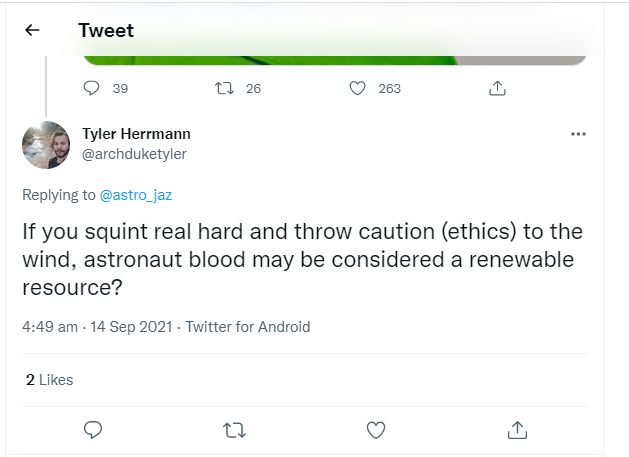
However, he did note that: “Just having the knowledge is always valuable. So there might be a situation like the Apollo 13 disaster, where (the astronauts) have to improvise to come up with a solution to a novel threat. So there may be some kind of emergency application, where knowing that blood mixed with Mars dust can produce material with a high compressive strength, could potentially be important.”
We spoke about the 44-minute time delay in communications between Earth and Mars and the potential to have an emergency ‘blood extraction machine’ to fill a leak in a ship or habitat. We laughed at the idea of astronauts living with a blood extractor in their cabin in case of emergencies “I hope we never have to use it”, he added.
Do you foresee any problems with this? Could it be required of the astronauts?
Aled said: “Yeah, I personally don't think this would ever be used. Some crazy billionaire might give it some serious consideration. But I think there will be other solutions that are more feasible.
"Our next step is to investigate plant-based biopolymers. So if you're growing soy milk peas in your (Mars) habitat, you could potentially use those proteins, or maybe they could be engineered on earth to be stickier. Super sticky rice! But this is a kind of initial kind of gateway concept.”
Are there any engagements that might be useful to engage with the societal and ethical implications of this work and how might your various engagements impact the work you are doing?
“I think engagement will be good, I think a lot of discussions so far is in the paper, and then the press release, media articles and then the interpretation of the public. I've read through a lot of the comments, newspaper articles and questions, to see what people pick up on and how they interpret it. It gives me some good thoughts on what to emphasise when publishing something similar in the future.
“One of the things I regret is that, although I suppose it's made the impact bigger, is that we're not actually using the red blood cells. There's a way you can extract this protein, human blood plasma, that puts all the important parts of your blood back in your body. So it's not as bad as a lot of people think, so anything, where there's dialogue, would be good.”
It is well known that the moon missions created important technologies that could be used on earth. Do you anticipate any other potential applications? How might this impact society?
“I think that the value of space exploration goes beyond making a second habitat for humans on the planet. The value is pushing loads of money into doing something really difficult and high tech, and there will be offshoot technologies.
"So yeah, the Apollo mission, we had solar panels and a huge amount of computer miniaturisation.”
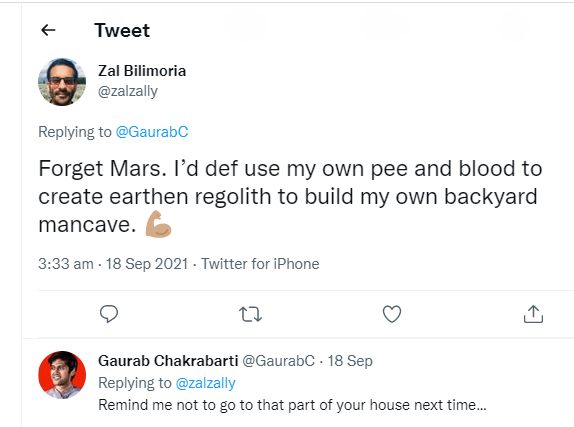
“I think an offshoot from a crewed mission to Mars could be better resource use technologies, fully set for circularity. We have to develop technologies that recycle everything really efficiently. The technological benefits, I think, outweigh the investment in pushing for this.
“In the context of these specific materials, there's definitely potential Earth-based applications. Moving beyond human blood, there are other proteins you can get from plants and other types of plant biopolymers that can be used as a binder for materials on earth. And if it's used as a replacement for concrete, that will be very good because cement and concrete account for about 8% of CO2 emissions.
“From our need to be hyper resourceful travelling space, maybe there'll be some kind of offshoot technologies where it will trickle down and we can develop a sustainable, circular economy. Super circular circularity like a complete circle, not just, like, try and recycle some things.”
Would you be able to reflect on your view on the convergence of technologies and how that might lead to exciting and unexpected outcomes?
"Yeah, absolutely, there is a lot of low hanging fruit on the interface of different disciplines and different technologies and it's very hard to make progress in pure fields these days. If you do interdisciplinary work, there's a lot of potential there for your really advanced novel, breakthrough technologies. I think that's really interesting.
“However, I do detect a lot of hype. I think it's important to be honest, and not overhype technologies, but it's difficult in science because those that claim their technology is revolutionary and world-changing are the ones that get the investment and funding to pursue it whereas those who are more realistic often find their work being overlooked.
"So yeah, there’s an unfortunate problem in science now where money after the hype is kind of wasted because the technologies aren't as good as the claims.”
Afterthought
Overall, Aled’s far-reaching vision surpassed the immediate impacts of the project, as he identified Mars-mission derived opportunities for spillovers in areas like hyper-circularity and resourcefulness. He saw this project as contributing a part of that effort, with potential uses and impacts here on Earth.
The idea of ‘moonshot’ innovations are re-surfacing in science policy circles and this conversation indicates that these ideas endure in scientists like Aled. It surprised me that a conversation about interplanetary travel could lead us to a discussion of the merits and drawbacks of academic science.
I was particularly interested to hear him reflect on the fact that hype surrounding the project had assisted its distribution even though it may have led to some misunderstanding amongst the public. The effort to create albumin-based building materials illustrated an interesting tension where rigid scientific accuracy is pitched against exciting science communication and the need to gain funding and investment.
I was also glad to see that Aled had thought through the implications of his work before publication and that astronauts would not be signing waivers for compulsory blood donation. That being said, there was recognition that the ‘genie had been let out of the bottle’ in terms of communicating that blood cells would not be used, suggesting that two-way communication may have been useful in the run-up to publication and dissemination.
This type of engagement can play an important role in the efforts to align scientific progress with the needs and values of the public (who are often the ones funding the research). Aled’s willingness to engage with the tweets, and to reflect on his role as a scientist provides a good model for those who want to demonstrate a commitment to innovating responsibly.
Words by Adam McCarthy
Adam is a PhD student at the Manchester Institute of Innovation Research, Alliance Manchester Business School.
His research interests are Responsible Research and Innovation and how the emergence of engineering biology can be governed for sustainable development.
Email Adam for more information.
